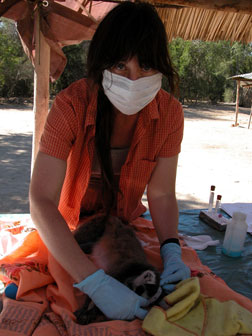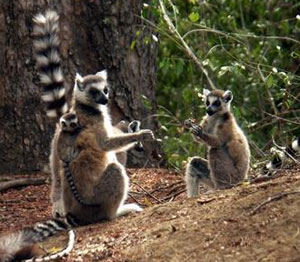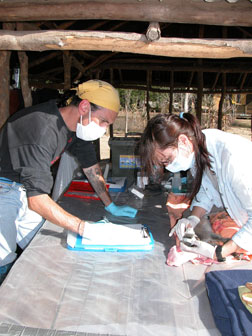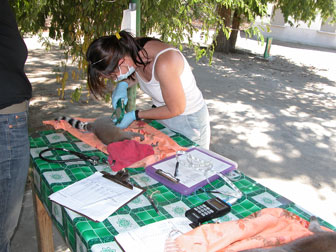Lemurs at risk due to invasion of feral beasts, global warming
Feral beasts threaten lemurs in Madagascar:
An interview with lemur expert Dr. Michelle Sauther
Rhett A. Butler, wildmadagascar.org
February 7, 2007
The lemurs of Madagascar are among the world’s most threatened primates. Extensive habitat destruction, hunting, and the introduction of alien species have doomed dozens of species to extinction since humans first arrived on the island within the past 2000 years. Most of the casualties were Madagascar’s largest lemurs — today the biggest lemur is but a fraction of the gorilla-sized giants that once ruled the island.
Despite this relative impoverishment of megafauna, Madagascar still boasts nearly 90 kinds of lemurs, all of which are unique to the island (save one species that was probably introduced to some nearby islands). Lemurs display a range of unusual behaviors from singing like a whale (the indri) to sashaying across the sand like a ballet dancer (the sifaka). Interest in lemurs has helped Madagascar become a global conservation priority, though they are still at risk. Continued deforestation, scattered hunting, and looming climate change all pose significant threats to some lemur populations. One largely unexamined threat comes from introduced species such as the Indian civet and mongoose, but especially dogs and cats that have become feral.
 Dr. Michelle Sauther in her University of Colorado-Boulder office. |
Dr. Michelle Sauther, an anthropologist at the University of Colorado at Boulder, is currently developing a project to assess this threat. Specifically she plans to examine the impact of introduced mammals on the iconic ring-tailed lemurs and Verreaux’s sifaka at the Beza Mahafaly Special Reserve in Madagascar.
Dr. Sauther has studied the ring-tailed lemurs of Beza Mahafaly since 1987 and helps run the Beza Mahafaly Lemur Biology Project, an initiative that seeks to better understand how lemurs are responding to habitat change. In February 2007, Dr. Sauther answered some questions from WildMadagascar.org / mongabay.com about her work.
Mongabay: How did you get involved with lemur research? Do you have any tips for students wanting to pursue a career in primates conservation?

Dr. Michelle Sauther monitoring body condition in a ring-tailed lemur at Beza Mahafaly, Madagascar |
Sauther: I grew up in Montana so I was always poking around the environment. This was probably not so smart since I was enamored with prairie dogs, but rattlesnakes often overtook their dens! Fast-fowarding to college, I was originally interested in issues of sex differences and human evolution. I took a primate class and realized that I could combine my interest in animals with my research focus. My doctoral advisor had been a long-time “lemurologist” and the ring-tailed lemur was perfect for a study of sex differences since the females were dominant to the males. No one can work in Madagascar for long without realizing the importance of conservation and in 2003 my work became primarily focused on that. The number one tip I have for anyone interested in studying primate conservation is to do your homework. Find an advisor that shares a common interest and who has a good track record of being an excellent mentor. You will be learning from that person for a long time.
Mongabay: Last spring a team of scientists writing in the journal Science said that Madagascar’s extraordinary levels of biological diversity results from the “configuration of watersheds” and “geologically recent shifts in climate”. How will future climate change impact Madagascar’s biodiversity?
Sauther: It is amazing that with all that the lemurs currently have to face, they will unfortunately also be exposed to another threat, global warming. Already we have seen the change at the research site I work at called Beza Mahafaly. We work there during what is supposed to be the dry cool season every year (June — August). During the past three seasons we have had to deal with torrents of rain. In addition we have had drought, and a recent cyclone caused the whole reserve to be flooded. The result was dramatic as it affected the fruiting of their major food resource, the Tamarind. Few fruits were produced and many females and their infants did not make it through that year.
Mongabay: Your work has focused on the charismatic ring-tailed lemur, a generalist when it comes to feeding. How will they fare in a warmer world? Will generalists do better than specialists under changing climate?
 Ring-tailed lemurs in Madagascar. Photo by Rhett A. Butler |
Sauther: It seems like generalists have always fared better. We already see that in Madagascar’s recent lemur extinctions. The large specialized fauna did not make it, and the most generalized of the so-called “fossil lemurs”, Archaeolemur, were able to make a living all over the island, and they appear to have survived the longest. As noted above, global warming is already having an effect on the lemurs. What is interesting is that at Beza the only troop that made it through the year, when the reserve was flooded, without any mortality was the one who come into our research camp. These lemurs exploit water resources (from the well) as well as use discarded foods such as carrots, mangos and squash. Several of the groups also exploit human crops so as generalists they do have the ability to rapidly add to and/or change their resource base. There is a limit, however.
Mongabay: A number of theories — most revolving around the arrival of man on the island and his use of fire — have been proposed for the extinction of megafauna. What does your research suggest was the culprit?

Dr. Michelle Sauther and Dr. Frank Cuozzo determining health status in a ring-tailed lemur at Beza Mahafaly in Madagascar. |
Sauther: This appears to be the result of a number of factors working together. Climate change, especially increasing aridity, along with human actions appear to have created a synergy that affected Madagascar’s landscape ecology. Where I work at Beza, there is a phenomenal fossil site called Taolambiby where remains of the giant fossil lemurs were found along with the smaller lemurs still alive at Beza, such as Verreaux’s sifaka and the ring-tailed lemur. Interestingly, at Taolambiby it’s the Verreaux’s sifaka who appear to have been the major lemur hunted and consumed by humans and yet they are still around. Cultural change has also occurred because today it is fady (taboo) for the local people, the Mahafaly, to hunt lemurs. It may be that there were different stressors in different parts of the island, but the end result was the loss of the larger animal fauna.
Mongabay: I understand that your are developing a project that will examine the impact of introduced species on endangered lemur populations — can you tell me more about the project?
Sauther: As I said, we currently have a crisis at our reserve. Domestic dogs are common in and around the villages in the Beza Mahafaly area, and are often used to guard domestic livestock. Domestic cats are also common in these villages, possibly to mitigate rodent populations. However, feral cats (locally “ampaha”) have also been observed in the Beza Mahafaly reserve and surrounding region. This large felid represents a truly feral domestic cat, possibly the African or European wild cat (Felis silvestris, Felis lybica), or a potential hybrid. Although domestic dogs are useful in this pastoral society, feral dogs are becoming an increasing problem for local people, as they are known to attack domestic livestock (i.e., young goats and sheep). Feral cats are also known to attack poultry.
The past several years have seen a population explosion among the feral dogs so the introduced predators are having an observable impact on the local economy. These introduced species are also impacting the Beza Mahafaly lemur population. In 2006, there were two eyewitness accounts of feral dog kills of ring-tailed lemurs, one an infant (less than one year old), the other a collared adult female. Two Verreaux’s sifaka were also subject to dog attacks during 2006: one survived with the aide of veterinary treatment, the other died despite veterinary efforts. Since 2003, we have seen evidence of feral dog predation of lemurs in canine feces (i.e., lemur hair and bone), we have found lemur skeletal material with signs of predation and we have numerous accounts of both feral dogs and cats stalking both ring-tailed lemurs and sifaka. We need to systematically assess the threat of predation by these introduced species on the Beza Mahafaly lemur population to develop a feasible plan of action, and we are looking for donors to help. (Contact Dr. Sauther if you would like to help:  ).
).
Mongabay: What does the future hold for lemurs? Are current conservation efforts going to be enough to save lemurs from extinction? How effective are these efforts? What needs to be done to conserve Madagascar’s biodiversity?

Dr. Michelle Sauther measuring a ring-tailed lemur in Madagascar. |
Sauther: One good lesson I have learned from working in Madagascar these past twenty years is that conservation has to be carried out at two levels, the national and the regional. At the national level the current president, Marc Ravalomanana has a solid plan. He is trying to make Madagascar more investor friendly, because the only long-term conservation solution requires improving the livelihood of Madagascar’s people. At the same time he has increased, three-fold, the areas to be protected. This is where the regional part comes in. There is no “one size fits all”, when it comes to conservation. In the south, where I work, the economy of the region is based on pastoralism and dry farming and we have very different conservation issues than those found in rainforest habitats. We also have to expand conservation-related research. Primarily the focus has been on habitat destruction, which is of course critical. However, there are other major threats. One of these is hunting. Eric Patel, for example, reports that in some areas lemurs are being actively hunted with guns and traps to provide upper middle class people with “picnic food” (see Laboratory Primate Newsletter, 2006, 44 (3): 8-11). At Beza there is a taboo among the local Mahafaly against killing lemurs, but further north of the reserve non-Mahafaly have been coming into the forests to hunt lemurs. Disease transfer from domestic animals is also a concern, and at Beza we have been trying to understand the effect of domestic animals on lemur health. Finally, at Beza we are facing a crisis as packs of feral dogs are now attacking and killing lemurs in the area. So conservation issues really can vary from place to place.
Mongabay: Is there anything people can do abroad to help save lemurs and Madagascar’s wildlands? What role does eco-tourism have in conservation on the island?
Sauther: I would really like to see people become “working tourists” in Madagascar, e.g. bringing their particular expertise, be it in business, economics, communication, etc. to help current programs and projects in Madagascar. Right now there doesn’t seem to be any way to link such people to projects, so developing this link would be an important component. I know people want to help, and this would be a great way for them to see the beauty of Madagascar’s wild places while doing something concrete to help maintain the island’s unique environment.
Beza Mahafaly Lemur Biology Project
Paw Madagascar – Feral animal management to protect lemurs














